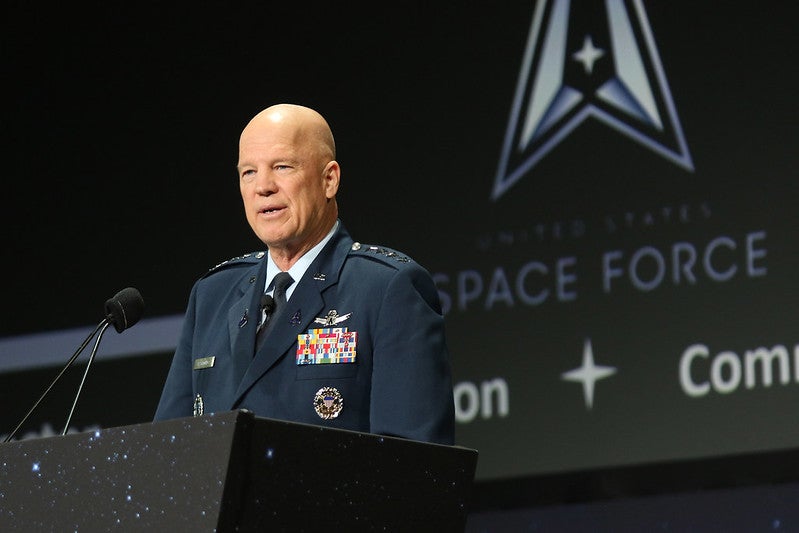Latest News
U.S. Space Force Wants to Avoid GMTI Duplication with Intelligence Community Programs

Chief of Space Operations Gen. John “Jay” Raymond addresses the Space Symposium in Colorado Springs on Apr. 5. Photo: Space Symposium
The Department of the Air Force is to take advantage of efforts led by Vice Chief of Space Operations Gen. David ‘DT’ Thompson on future ground moving target indication (GMTI) and of collaboration on GMTI between the department and the intelligence community, including the National Reconnaissance Office (NRO), to prevent duplication of programs.
Chief of Space Operations Gen. John “Jay” Raymond disclosed a Space Based Radar (SBR) GMTI effort last year.
“We’re looking at some of the things people have already planned to see if they’re gonna be adequate, ” Air Force Secretary Frank Kendall said on Apr. 5 during a press conference with Raymond at the Space Symposium in Colorado Springs. “There’s some work that’s been going on for a while to address these requirements to try to sort it out. We’re bringing that all together to make sure we’ve got the requirements right and then look at all the trade-offs we need to make before we make a final decision.”
The Department of the Air Force is to complete a force design for future GMTI using a possible mix of space and air assets this year in advance of the fiscal 2024 budget submission. The Space Force Space Warfighting Analysis Center (SWAC) has been investigating that future force design as SWAC’s second priority force design. SWAC delivered its first force design on hypersonic missile warning and tracking — a proposed mix of low and medium Earth orbit satellites–in January.
The Department of the Air Force’s fiscal 2023 budget indicates that the department plans to retire its 12 remaining Northrop Grumman E-8C Joint Surveillance Target Attack Radar System (Joint STARS) GMTI planes–eight in fiscal 2023 and four in fiscal 2024–and to use other intelligence, surveillance, and reconnaissance (ISR) assets to fill in for the loss of Joint STARS.
“The work we’re doing on GMTI is in partnership with the NRO,” Raymond said on Apr. 5. “We’re looking through exactly what the requirements are, how you invest and do this together so there is no duplication. We’re not in the business of duplicating. We need to get capability on orbit at speed.”
The Air Force has said that it continues “to operate multiple ISR platforms with GMTI capability and plan to do so across the duration of the coverage reduction caused by JSTARS retirement.”
Other Air Force aircraft besides Joint STARS with GMTI include the U-2 with the Raytheon Technologies ASARS-2 radars, the Northrop Grumman RQ-4 Block 40 Global Hawk with the Raytheon AN/ZPY-2 radar, and the RQ-170 Sentinel by Lockheed Martin. The Advanced Battle Management System (ABMS) — the Department of the Air Force initiative under Pentagon Joint All Domain Command and Control (JADC2) — is to aid the integration of such sensor information for targeting.
In addition to Air Force GMTI, other services have some GMTI. For example, the U.S. Navy MQ-4C Triton aircraft by Northrop Grumman has GMTI, while the U.S. Army De Havilland Canada (DHC) Airborne Reconnaissance Low aircraft have GMTI. In addition, Leidos has been working with the Army on possible GMTI on a modified Bombardier 650 business jet that Leidos owns. While the 1948 Key West Agreement–and its modifications–carving out service mission areas appear to prohibit Army aerial reconnaissance jets, the stipulations may contain a loophole for contractor-owned test assets.
The first two Joint STARS developmental aircraft gained prominence during Operation Desert Storm in 1991 for their role in tracking and targeting Iraqi units and equipment, including Scud missile launchers. The U.S. also used Joint STARS during operations thereafter in Kosovo, the Middle East and Afghanistan. At their best, the Joint STARS helped U.S. forces to track and target enemy units or to force such units to disperse, camouflage themselves, and dig in, in which case U.S. and allied ground forces were able to target or bypass them.
Kendall has suggested that the sustainment costs for Joint STARS are too high and that the aircraft needs replacement.
Kendall said late last year that he had entered into discussions with NRO Director Chris Scolese and Director of National Intelligence (DNI) Avril Haines on coming up with the right mix of air and space sensors for GMTI. The NRO has traditionally provided intelligence gleaned from space sensors to the national command authority, not military forces in the field.
Space-based GMTI has shown promise in other nations’ research efforts, including the Canadian RADARSAT-2 experiment and the Chinese Gaofen-3 low Earth orbit remote sensing satellite.
The U.S. has initiated space-based GMTI efforts before–efforts that entailed cost estimates in the tens of billions of dollars for an operational system. In 1998, the Air Force, Defense Advanced Research Projects Agency (DARPA), and the NRO began the Discoverer II program to explore high-resolution space-based GMTI, but Congress canceled the program in 2000.
In 2004, the Air Force awarded a Lockheed Martin team a contract for Space Radar, but the Pentagon killed the program in 2008 as being too costly.
A 2007 report by the Congressional Budget Office (CBO) estimated the cost of a space-based GMTI radar system as ranging from nearly $26 billion to more than $94 billion.
Whether the Space Force will succeed in limiting the cost of developing, fielding, and sustaining SBR remains to be seen.
Get the latest Via Satellite news!
Subscribe Now